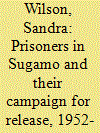|
|
|
Sort Order |
|
|
|
Items / Page
|
|
|
|
|
|
|
| Srl | Item |
| 1 |
ID:
075265


|
|
|
|
|
| Publication |
2006.
|
| Summary/Abstract |
This is the third and final installment of Um Jabr's "life story," earlier segments of which-on village life in pre-1948 Palestine and on the 1948 war and its aftermath-were published in JPS 138 (winter 2006) and JPS 140 (summer 2006). The current excerpts focus on Um Jabr's intense involvement in the prisoner issue that began when two of her sons were in Israeli jails. In particular, her activism took the form of organizing other women to visit prisoners from Arab countries who had no one to visit them on the twice monthly visits allowed. Um Jabr's 36,000-word "life story" was one of seven collected as part of an oral history project, as yet unpublished, carried out by Barbara Bill, an Australian who since 1996 has worked with the Women's Empowerment Project of the Gaza Community Mental Health Program, and Ghada Ageel, a refugee from al-Bureij camp now earning her Ph.D. at the University of Exeter in England. The women who participated in the project were interviewed a number of times during the first half of 2001; after the tapes were transcribed, the memories were set down exactly as they were told, the only "editing" being the integration of material from the various interviews into one "life story." Um Jabr, who was in her early 70s at the time of the interviews, still lives in al-Bureij camp, where she has since 1950.
|
|
|
|
|
|
|
|
|
|
|
|
|
|
|
|
| 2 |
ID:
106798


|
|
|
|
|
| Publication |
2011.
|
| Summary/Abstract |
The great majority of Japanese war criminals served part or all of their sentences in Sugamo Prison in Tokyo, either because they had been tried in Japan, or after repatriation from overseas. Once convicted, they tended to be invisible in historical accounts of the post-war period, but in fact they were not cut off from Japanese society or politics in the 1950s. Rather, Sugamo's inmates worked hard to win public sympathy, also exerting considerable pressure on the government in an attempt to hasten their own release and to have Japanese prisoners repatriated from overseas gaols. The early 1950s were crucial, not least because the 1952 peace treaty stipulated that the countries that had originally prosecuted them retained the right to decide on prisoners' fates even after Japan regained its sovereignty. Moreover, convicted war criminals were increasingly concentrated in Sugamo, allowing many opportunities for political activity and other campaigning. Though the last war criminals were not freed until 1958, prisoners' activities in the early 1950s played an important part in changing the terms in which discussion of war criminals took place and thus in making it more and more difficult for foreign governments to maintain their original stance on war criminals.
|
|
|
|
|
|
|
|
|
|
|
|
|
|
|
|
|
|
|
|
|